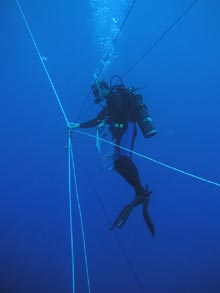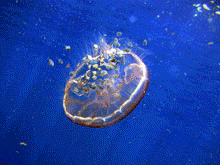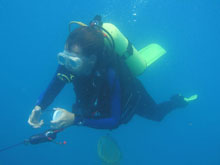
Marine scientist spiderman Misha Matz coordinates a blue water dive for 4 companions -- each at the end of a rope tether and each rope kept taut by a weight and pulley system that is attached to a toilet flange. Click image for larger view.
Diving with No Bottom
September 3, 2005
Justin Marshall, Ph.D.
Marine Biologist
Vision Touch and Hearing Research Centre
QBI, University of Queensland
Australia
![]() Experience a blue water dive with Marine scientist as an Aurelia jelly floats along near the surface. (Quicktime, 904 Kb.)
Experience a blue water dive with Marine scientist as an Aurelia jelly floats along near the surface. (Quicktime, 904 Kb.)
Any scuba diver knows the slightly uneasy feeling of having to descend to a bottom that is out of sight due to poor visibility. Try looking down in crystalline conditions of 200ft visibility, still not seeing the ocean floor and indeed knowing that the bottom is half a mile below. Unease turns to awe as we embrace the experience of blue water diving and the ocean embraces us. This is one of those moments to leave you feeling very small and yet eager for more.
We are not doing this for the wow-factor, however. We are here as 4 floating specks in the middle of the Gulf of Mexico, 4 planktonic biologists trying to understand life in a world with no edges and no background. Through careful planning and with safety uppermost in mind, we are not like the real plankton that drifts past but are tethered to the support boat with climbing rope and a toilet flange. This toiletary-trapeze allows divers to swim towards and away from the safety diver while remaining un-entangled with rope and each other. We needed a strong, light, non-corroding ring with holes around the circumference and the local plumbers supply provided the perfect solution.
The task for this underwater circus is to collect and film marine zooplankton and begin to understand how they live in this blue, blue habitat with nothing to hide behind. The result through evolution, or the hand of God -- however you want to see it - is transparency. One way to hide here is to make your body totally see-through and, while difficult, several types of animals including vertebrates, mollusks, crustaceans and worms have managed it. Only the gut and the eyes can't be made transparent and these are often silvered on the outside instead in order to reflect the local blue of the ocean and also disappear. The result then is a cross between the invisible man and "Predator" and indeed this mix of aggression and subterfuge is the reason for these remarkable camouflage strategies.
So -- we know how they disappear. What we are working on is how this cunning camouflage is broken and animals revealed for food and sex? As we rapidly learn when trying to catch pelagic plankton for study onboard ship our eyes are not good here. What mechanisms might allow the invisible to be made visible in the open ocean? Two things we are working on are tricks known in several other animals but not in humans, ultraviolet (UV) vision and polarized light vision. Both might increase the contrast of organisms that are transparent to us but opaque in UV or when viewed by eyes sensitive to the polarized light known to be abundant in the ocean. We have no answers yet but using specially adapted cameras can get glimpses of what this world might look like.

A flotilla of fish follow a transparent drifting jellyfish, Aurelia aurita. Click image for larger view.




























